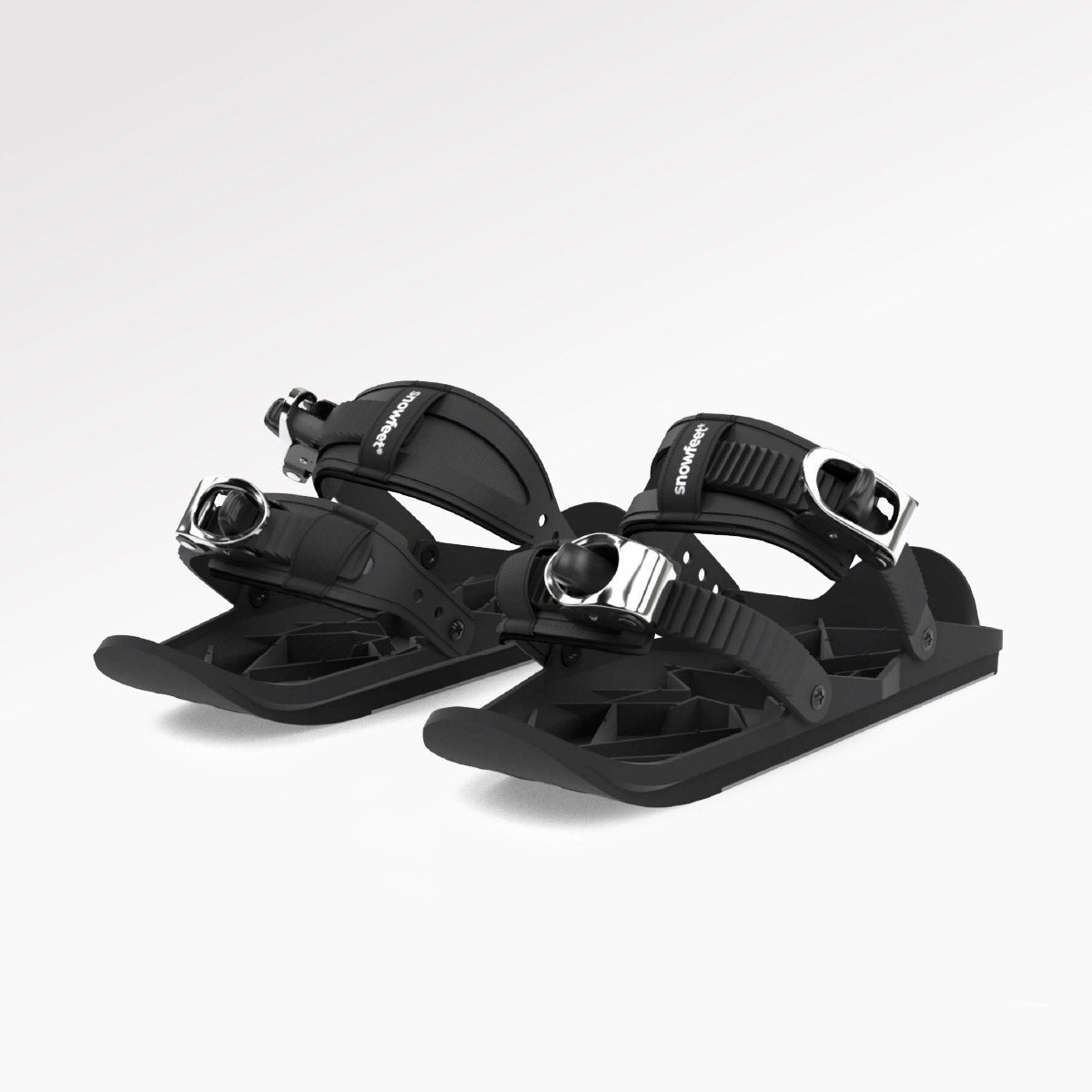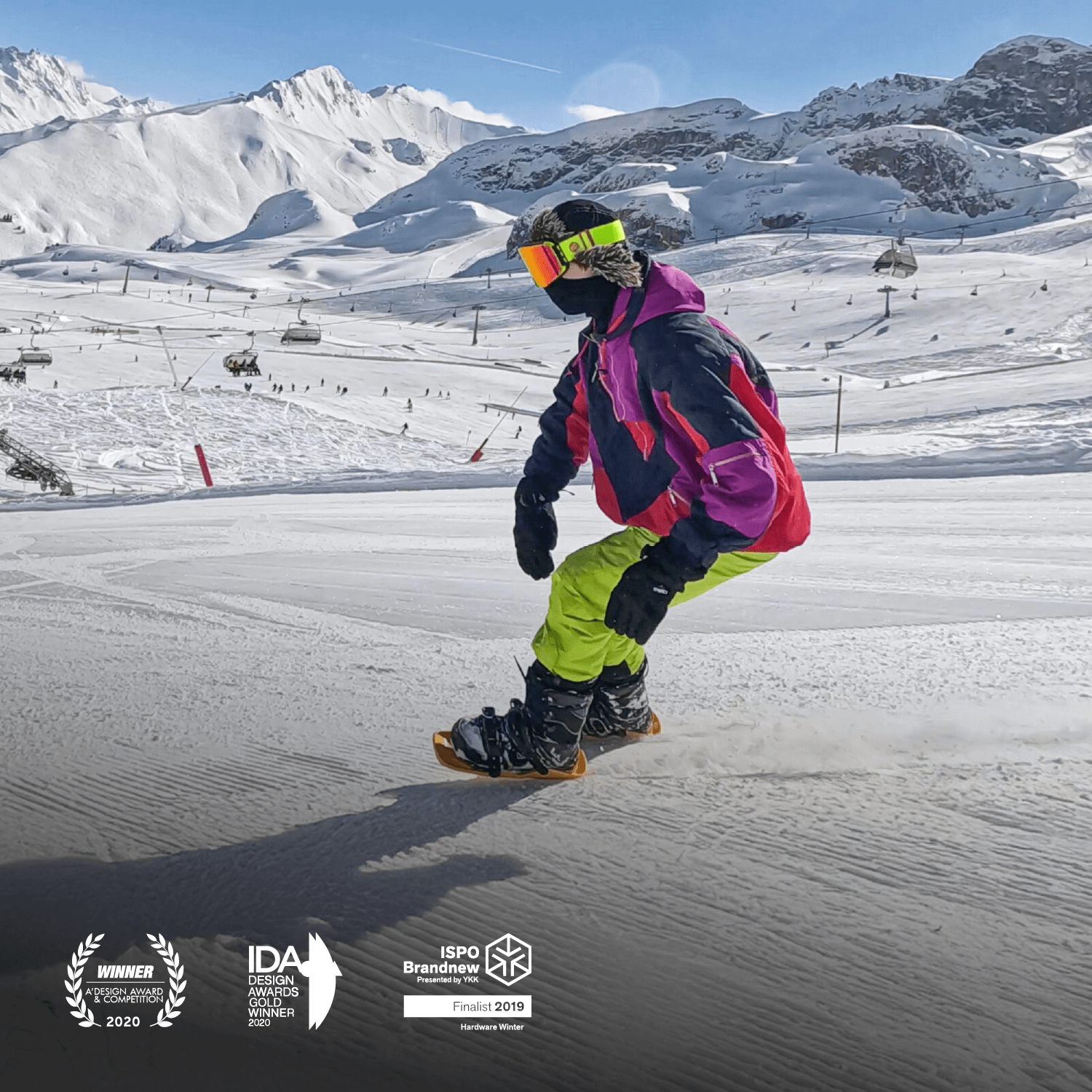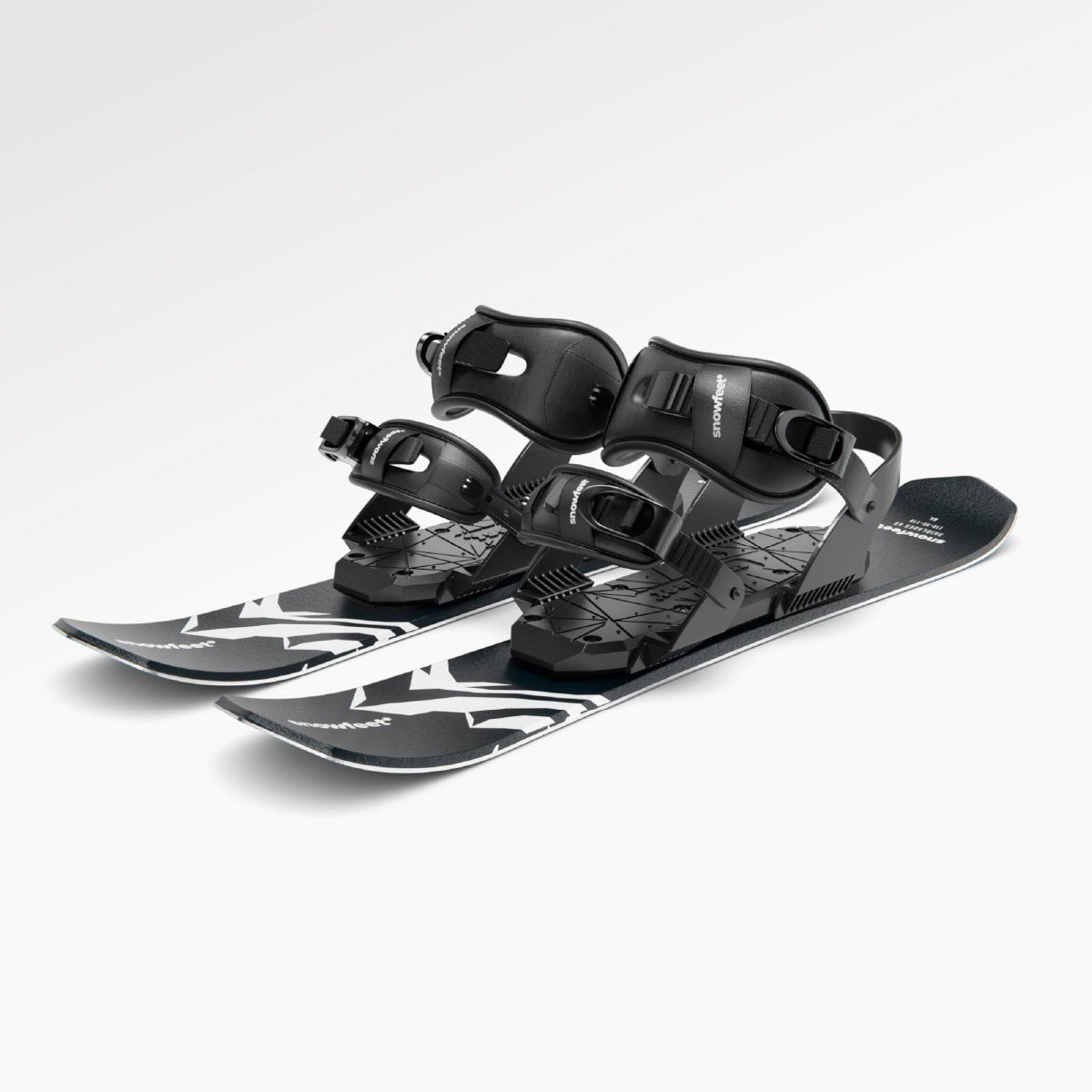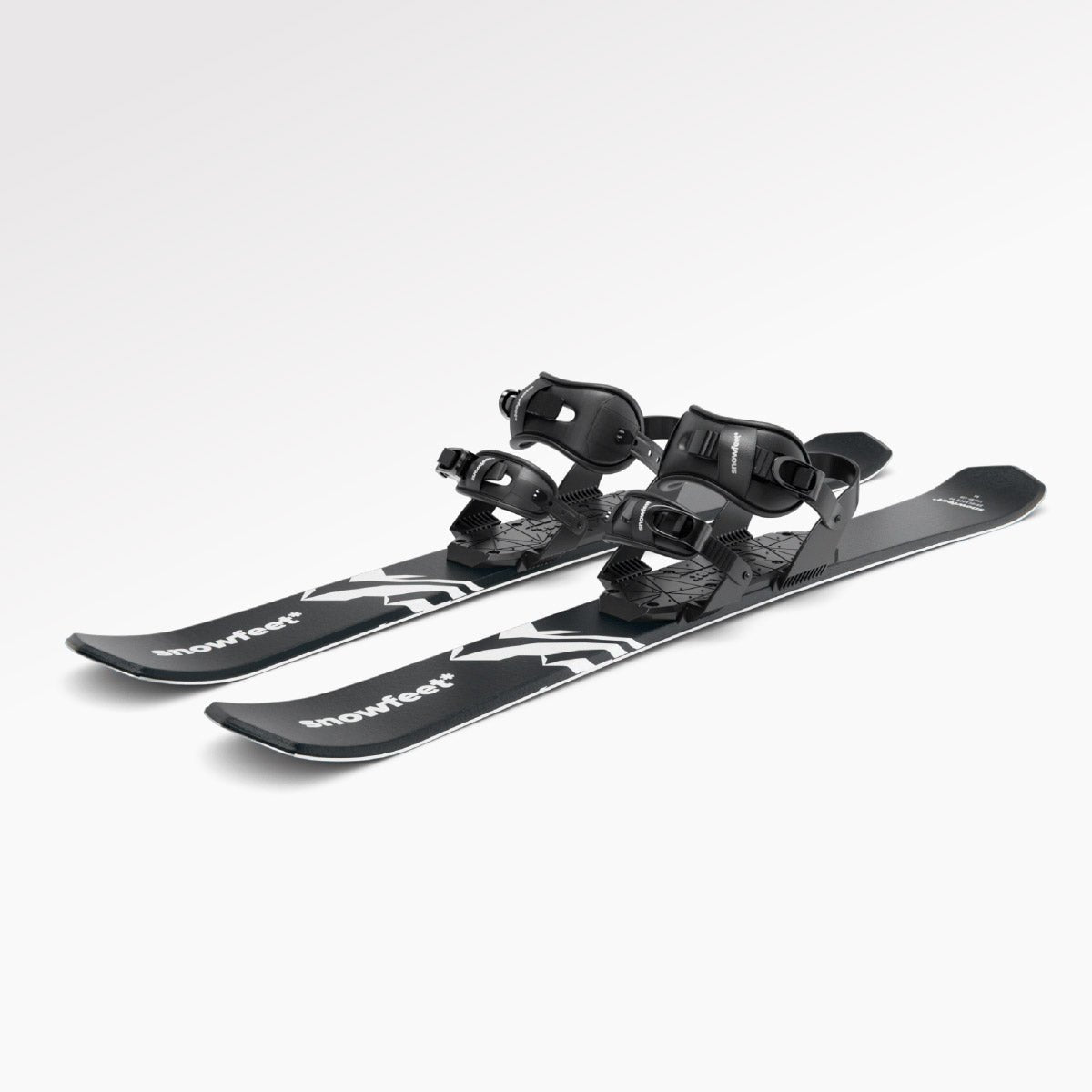Yes, you need specific boots for cross-country skiing. Regular winter boots won’t work because they can’t attach to the ski bindings or provide the flexibility and support needed for skiing. Cross-country ski boots are lightweight, have a metal toe bar or ridge for binding compatibility, and are designed to transfer power efficiently while keeping your feet warm and dry.
But here’s the good news: if the cost and complexity of traditional setups feel overwhelming, Snowfeet* offers a simpler option. Their compact skis and ski skates work with regular winter boots, snowboard boots, or even hiking boots. No specialized gear required. This makes skiing easier and more accessible.
Key Takeaways:
- Traditional Cross-Country Ski Boots: Necessary for proper binding compatibility, power transfer, and control.
- Binding Systems: Popular options include NNN, NNN BC, SNS Profil, and SNS Pilot.
- Snowfeet*: Works with your existing winter footwear, making it a budget-friendly and beginner-friendly alternative.
If you’re unsure about investing in specialized boots, Snowfeet* could be the perfect way to get started with snow sports!
Cross country ski, Roller ski BOOT GEAR REVIEW!
Why Cross-Country Skiing Requires Special Boots
Cross-country skiing calls for boots that do more than just keep your feet warm - they need to secure your foot to the ski while allowing your heel to lift naturally. Regular winter boots? They just don’t cut it. Let’s break down what makes these boots so unique.
What Makes Cross-Country Ski Boots Different
These boots are all about being lightweight and flexible - completely opposite from the bulky alpine ski boots you might be picturing. Most cross-country ski boots feature a metal toe bar or ridge built into the sole. This connects securely to the ski bindings, keeping your foot in place while allowing smooth forward motion.
The materials used are designed to keep you comfortable during this high-energy activity. Think moisture-wicking fabrics and just the right amount of insulation to keep your feet dry and warm. The trick? Striking a balance between flexibility for natural movement and enough support to help you stay steady on uneven trails.
Weight is a big deal here. Manufacturers use lightweight synthetic materials, minimal padding, and specially designed soles that work seamlessly with bindings. The heel stays free to lift naturally, making every stride efficient.
How Boots Affect Power Transfer and Control
Here’s where the magic happens: power transfer. Cross-country ski boots are built with a rigid toe area to ensure that every ounce of energy you push off with goes straight into the ski. Regular boots with soft soles just can’t deliver that kind of performance.
The thinner soles on these boots also give you better feedback from the terrain, helping you make quick adjustments as needed. Plus, features like built-in ventilation and moisture-wicking materials keep your feet comfortable, even during long sessions on the snow.
Cross-Country Ski Boot Types and Binding Systems
Getting the right combination of boots and bindings is crucial for both safety and performance. In the world of cross-country skiing, a few main binding systems dominate, each catering to different needs and styles.
Main Binding Systems: NNN, NNN BC, SNS Profil, SNS Pilot
New Nordic Norm (NNN) is the most popular choice today. These bindings feature a single guide ridge running along the boot sole and two pins that lock into toe holes. This setup offers a good balance of stability and natural heel lift, making it a favorite for recreational skiers on groomed trails.
NNN BC (Backcountry) takes things up a notch with sturdier boots and wider bindings. This design is built for deeper snow and rough terrain, making it ideal for off-trail adventures where durability is key.
The SNS (Salomon Nordic System) comes in two variations: SNS Profil and SNS Pilot. The SNS Profil uses two parallel guide ridges for a different feel, while the SNS Pilot includes an extra binding point near the ball of the foot. This second connection offers greater control, which is why it’s a go-to choice for competitive skiers who need precision.
It’s important to match boots and bindings perfectly. These systems aren’t interchangeable, so alignment is critical. However, if you’re looking for versatility, Snowfeet* products stand out by working with regular winter boots, bypassing the need for specialized gear.
Why Boot and Binding Compatibility Matters
Mismatched boots and bindings can lead to unexpected releases, poor energy transfer, and even safety risks. A proper match ensures that your movements translate efficiently into forward motion.
The boot-binding connection also affects your skiing style. For example, NNN systems offer more flexibility, making them great for recreational skiers who enjoy a natural, easy stride. On the other hand, SNS Pilot systems provide a more direct and responsive feel, which is why they’re often seen on racing skis where precision and energy transfer are critical.
Temperature changes can also impact how your gear performs. Cold weather can make plastic components brittle, while warmer conditions can cause slight expansion. A correctly matched system is designed to handle these fluctuations, but mismatched equipment might fail when you least expect it.
Before buying, take a close look at the boot soles. Check for guide ridges, pinhole alignment, and compatibility markings. Most ski shops can help confirm the match, but knowing these basics can help you make confident choices.
While traditional setups require specific pairings, Snowfeet* products simplify things by eliminating compatibility concerns, letting you use your usual winter boots.
sbb-itb-17ade95
Snowfeet*: No Special Boots Needed

Cross-country skiing often comes with a hefty price tag thanks to all the specialized gear you need. But Snowfeet* changes the game by letting you use your regular winter boots. No more stressing over compatibility charts or shelling out for expensive footwear - just grab your boots and go. Snowfeet* is designed to work with a variety of winter footwear, making skiing more accessible than ever.
What Boots Work with Snowfeet*?
The bindings on Snowfeet* are super versatile and can fit almost any sturdy winter boots. For the best experience, stick with boots that have firm soles and good ankle support. Hiking boots are an excellent choice - they’re stable, grippy, and perfect for snowy adventures.
If you have smaller feet, snowboard boots might be a great option for a snug fit, though they’re not a must. Already have ski boots? Those work too! Just make sure your footwear is waterproof, insulated, and fits securely. Avoid boots with overly flexible soles since they can affect your stability. Thanks to adjustable bindings, you can get the perfect fit without needing any tools - all from the comfort of your home.
Why Snowfeet* Short Skis Are a Game-Changer
Traditional cross-country skis often lock you into costly, complicated setups. Snowfeet* flips the script with a simple and compact design. Their skis range from 15 inches (38 cm) to 47 inches (120 cm), making them easy to carry, store, or even toss into your luggage.
Shorter skis also mean easier handling, especially for beginners. Snowfeet* is perfect for tight spaces and varied terrains - whether you’re on groomed trails, in your backyard, hiking through snowy paths, or hitting up a snowpark. They’re practical in situations where traditional skis just don’t work.
And let’s talk price. A full cross-country ski setup can run you anywhere from $500 to $800. Snowfeet*, on the other hand, starts at just $250 - and you can use the boots you already own. That’s a win for your wallet and your winter adventures!
How to Check Boot and Ski Compatibility
Matching your boots and skis isn’t just about comfort - it’s vital for safety and performance. The wrong combination can lead to equipment issues that you definitely don’t want while out on the slopes. Thankfully, checking compatibility doesn’t have to be complicated. Snowfeet* systems, for example, simplify this process by eliminating many of the typical challenges. Follow these steps to ensure your gear works together seamlessly.
Steps to Verify Your Boot and Binding Match
Here’s how to make sure your boots and bindings are a perfect fit:
- Identify your binding system: Check the sole plate on your boots. Most cross-country skis use systems like NNN (New Nordic Norm) or SNS (Salomon Nordic System). NNN boots feature two narrow guide ridges that run lengthwise, while SNS boots have a single, wider ridge. This small detail makes a big difference.
- Use manufacturer compatibility charts: Brands like Rossignol, Salomon, and Fischer provide detailed guides that list which boots match which bindings. These charts are updated regularly and include specific model numbers, so you’ll get precise information. Look for these charts online or ask for help at your local ski shop.
- Measure your boot sole length: If you’re buying online, this step is crucial. While many bindings have adjustable toe pieces, they only work within certain size ranges. For instance, bindings designed for sizes 6-10 won’t fit a size 12 boot, no matter how much you tweak them.
- Test in-store when possible: A visit to a ski shop can save you a lot of hassle. Staff can help you physically test the click-in mechanism and check the release tension. This hands-on approach is especially helpful for beginners, as it’s not always obvious when something feels “off.”
Once you’ve confirmed your boots and bindings are compatible, it’s time to focus on getting the right fit for maximum comfort and safety.
Getting the Right Fit for Safety and Comfort
Matching your boots to your bindings is just step one. Proper boot fit is equally important for comfort and preventing injuries. Here’s what to look for:
- Snug but not tight: Your boots should hug your heel and midfoot securely, but your toes need a little wiggle room. Cross-country skiing involves constant forward motion, so boots that are too tight can lead to numbness and discomfort during longer outings.
- Test the flex and heel movement: Bend forward in your boots to check the flex at the ball of your foot. Cross-country boots are designed to flex here for natural movement. Also, make sure your heel lifts cleanly without twisting or sliding sideways when clicked into the bindings.
- Consider temperature and socks: Try on boots with the same socks you’ll wear skiing, and do this when your feet are slightly cold. Temperature changes can affect fit, so it’s good to simulate real conditions.
- Think about your terrain: If you’re skiing on groomed trails, you’ll want a snugger fit for better control. For backcountry adventures, slightly looser boots can improve circulation, keeping your feet warmer during long treks. The goal is to strike a balance between control and comfort based on your skiing style.
- Allow for break-in time: Stiffer boots, in particular, need time to adjust to your feet. Plan for a few shorter ski sessions to break them in before tackling longer tours. This prevents any unpleasant surprises when you’re far from the trailhead.
Getting the right setup takes a bit of effort, but it’s worth it for a smoother, safer experience on the snow. A little preparation goes a long way!
Conclusion: Choose the Right Boots for Your Skiing Style
Picking the right boots depends on how you plan to ski. For traditional setups, you'll need specialized boots like NNN or SNS to ensure proper power transfer and control - these are a must for high-performance skiers.
But if you're looking for something more flexible, Snowfeet* offers a whole new approach. Forget about specialized ski boots - Snowfeet* works with regular winter boots, hiking boots, or snowboard boots. With over 5,500 reviews averaging 4.9/5, users rave about how "easy and fun" it is to use.
You can stick with the winter footwear you already own - just make sure they’re waterproof, provide good ankle support, and have sturdy soles. Snowfeet*’s adjustable bindings are designed to fit most winter shoes, so whether you're cruising groomed trails, tackling ski slopes, or just playing around in your backyard, you're good to go.
FAQs
How are Snowfeet* products different from traditional cross-country ski boots in terms of performance and convenience?
Snowfeet* take a different approach to winter sports gear by completely ditching the need for specialized cross-country ski boots. Unlike traditional setups that demand you match specific boots to binding systems, Snowfeet* are made to strap onto any sturdy winter shoes or boots you already own. That means less hassle and more convenience, no matter your skill level.
When it comes to performance, Snowfeet* shine with their portability and ease of use. Forget lugging around bulky skis - these are compact, quick to set up, and give you the freedom to move. Whether you're gliding along groomed trails or tackling more rugged terrain, Snowfeet* offer a lightweight, no-fuss alternative to traditional cross-country ski gear.
Can I use my regular winter boots with Snowfeet* products?
Snowfeet* products are designed to work seamlessly with most winter boots and snowboard boots. As long as your boots provide solid ankle support and fit securely, they’ll pair up just fine with Snowfeet*. The best part? You don’t need to splurge on specialized footwear, unlike traditional cross-country skis or snowboards that often require specific bindings and boots.
What sets Snowfeet* apart is how lightweight and portable they are. They offer a hassle-free alternative to bulky gear, making it easy to hit the slopes or trails. Whether you’re in it for the fun or the workout, you can dive right in using the boots you already own.
What makes Snowfeet* a better option for beginners compared to traditional cross-country skis?
Snowfeet* are a great option for beginners because they’re lightweight, easy to handle, and work with your regular winter boots. Unlike traditional cross-country skis that need special boots and bindings, Snowfeet* cut out the extra gear, making them super simple and beginner-friendly.
Their compact size means they’re easier to carry and control, so you can spend more time enjoying the slopes and less time wrestling with bulky equipment. Plus, they offer a fun mix of portability and flexibility, making them an exciting choice for anyone just starting out with skiing.


















Laisser un commentaire
Ce site est protégé par hCaptcha, et la Politique de confidentialité et les Conditions de service de hCaptcha s’appliquent.